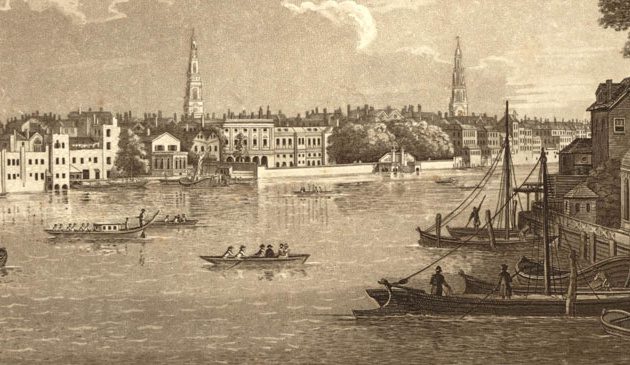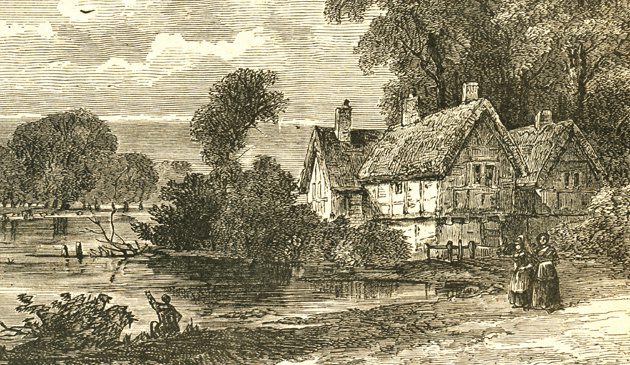Huguenots

In his painting and subsequent print The Four Times of Day: Noon (a detail shown here), created in 1738, William Hogarth contrasted the prosperous, smartly-dressed and sober Huguenot churchgoers with the more chaotic group of English outside the tavern on the opposite side of the street. The full version of the print has the steeple of St. Giles-in-the-Fields in the background, indicating that the location is Soho. Hogarth was well-acquainted with the diligence and skilfulness of Huguenot craftsmen in the area.
Spitalfields takes its name from the medieval priory of St. Mary Spital, which had been dissolved during the reign of Henry VIII. The area sat outside of the City wall, semi-rural for the following two centuries due largely to regulations that prevented the spread of London. It was after the relaxation of that prohibition in the 1660s, and the need for new housing after the Great Fire of London in 1666, that the area began to be developed, mostly of the smaller and cheaper sort of dwellings. Even before their arrival in the 1680s there were indigenous silk-weavers living there. Very soon, the great influx of Huguenots accelerated the changes at Spitalfields. With cheap housing, beyond the strict City regulations, but still close to open countryside, and with an existing infrastructure for weavers, Spitalfields must have seemed an attractive place for the new arrivals. The whole area took on a gallic atmosphere and their Calvinist belief in self-discipline created a degree of sobriety. Many Huguenots who initially settled there came from Lyon and Tours and probably knew each other before they arrived.
Silk, particularly ribbons, was extremely popular at the time but, unlike the new immigrants, English weavers lacked the skills to produce wider silk materials to create clothing such as dresses and waistcoats. Previously, silk fabric had been imported from France, with high import duties. Produced locally by Huguenot weavers made it cheaper, more affordable, and consistently available to the English market. In 1684 John Larguier from Nîmes became master of the Weavers’ Company. The following year the Company was granted a Royal Charter giving it authority over all weavers in London, Westminster, Southwark and a radius of 20 miles beyond.
The silk business was complex, involving skills and knowledge from, at one end of the process, the importation of the raw product, through to the spinning, weaving, design, dying, and selling of the finished material. There was also a great variety of types of woven material. The production was mostly controlled by master-weavers but much of the work carried out by journeymen who worked from their home. In 1719 Daniel Defoe, who took a great interest in Britain’s economy, described the wool and silk industries as the “most considerable and essential part” of the nation’s wealth.
In the years following their arrival some of those in the silk trade living at Spitalfields became wealthy and desired grand houses in which to live. Larger and more elegant and distinctive houses were constructed in Spitalfields, replacing older, smaller dwellings. Some houses, used as workshops, had large windows to receive the maximum amount of light, with their weavers’ looms in the attic directly under the windows cases. There are surviving examples on Fournier Street, Princelet Street and Wilkes Street, constructed during the 1720s. Some of the larger buildings had multiple occupation, with a family and workshop on each floor.
Not all new houses at Spitalfields were for affluent families. Former fields continued to be developed with more affordable dwellings throughout the 18th century, gradually urbanising the entire Spitalfields, Shoreditch and Bethnal Green areas, mostly with modest housing. Almost none of these types of properties exist today.
Initially Huguenot gold and silversmiths moved to London’s centre of the trade, in the City around the Goldsmiths’ Company, but the existing English members closed ranks against the newcomers. The immigrant craftsmen therefore moved elsewhere, to Soho. Their arrival coincided with the development of this new London suburb, which until the 1670s had consisted of open fields. Unlike neighbouring St. James’s, which came into existence at about the same time, it became a district of homes and workshops for artisans such as clock-makers, silversmiths and goldsmiths, and thus suited the new immigrants. So many French lived around Gerrard Street, Great Windmill Street and Newport Market that in the mid-18th century it was said that one could imagine yourself in France.
There were pockets of Huguenots who settled in other locations just outside of the City, including Clerkenwell, Mortlake and Fulham. The former French government minister, Marquis de Ruvigny, had on several occasions represented France at the English court. Prevented from holding office after the revocation of the Edict on Nantes in 1685, he settled at Greenwich where a significant Huguenot community grew. They initially worshipped at St. Alfege church until the Marquis oversaw the founding of the French church at Greenwich.
Huguenots also began to settle at Wandsworth from 1631 and in 1682 twenty-one of them wrote to the Bishop of London to request the creation of a French conformist chapel off Wandsworth High Street. Its founding encouraged other Huguenots to move out of London to this quieter neighbourhood. A burial ground was established in 1687. Many who settled there were from Dieppe and Rouen although they included some Dutch Protestants. Huguenot artisans set up along the fast-flowing River Wandle, which they used in the manufacture of metalwork, and silk-dying. One calico printing factory employed 200 workers. Some who fled Caudebec in Normandy were skilled in the secret art of felt-making, producing hats that were prized throughout Europe. ‘Wandsworth Scarlet’ silk, using a method of fixing a red dye, was used by the East India Company for its soldiers’ uniforms.
In their homelands, where they had suffered generations of persecution, Huguenots had a long tradition of mutual assistance groups that they brought with them to London, helping the elderly and infirm amongst them. As immigrants, they were unable to claim Poor Relief when they fell upon hard times. The City of London provided them with a large house near Bunhill Fields and there a hospital was established. In 1718 it moved to Bath Street at Finsbury, becoming the Hospital for Poor French Protestants, or simply the ‘French Protestant Hospital’. Initially it could manage 80 inmates but by 1760 extensions to the building allowed for up to 234 residents. (It continues as sheltered accommodation and is now located in Rochester, Kent, still governed by descendants of the original benefactors). In 1719 the Threadneedle Street church opened a school for one hundred boys and girls and a second school opened nearby in 1745. There were various other Huguenot schools in and around London, such as the Westminster Protestant School.
Silk-weaving was susceptible to frequent periods of interruption due to lack of raw materials or changes in fashion, each downtime leaving workers in financial difficulties. La Maison de Charité de Spitalfields (or ‘La Soupe’) was founded in 1689-90 to serve meals for Huguenots around Spitalfields and Bethnal Green who could not provide for themselves. In the 1740s there was so great a need for the charity’s services that it could no longer afford the cost of whole meals and therefore reverted thereafter to merely distributing bread.
By the 18th century so many Huguenots were living in London that they had established 31 churches. One of the largest concentrations was in or close to the Spitalfields area where there were at least nine by 1700. Three former Huguenot chapel buildings still survive at Spitalfields: L’Eglise de L’Artillerie, built in 1766 on the old artillery ground, was taken over by Ashkenazi Jews in the 1840s to become the Sandys Row synagogue; La Patente in Hanbury Street, was built in 1719 and is now the Hanbury Hall arts centre; and L’Eglise Neuve on the corner of Fournier Street and Brick Lane, which became a Wesleyan chapel. The latter then continued as a synagogue in the late 19th century and a mosque in the 1980s. In Soho there were up to fourteen French Protestant churches.
Such was the growth in number of non-conformist churches that there was concern within the Church of England. In 1683 the Bishop of London discussed the idea of countering this rise with new Anglican churches in areas populated by Huguenots. At that time London, and in particular St. Paul’s Cathedral, was still being rebuilt after the Great Fire so funds were unavailable. By the early 18th century the financial situation had changed and the Act for Building Fifty New Churches became law. It resulted in several splendid new Anglican churches in London, including Christ Church at Spitalfields. The version of the Marriage Act that was law from 1753 until 1836 required marriages other than those of Jews and Quakers to take place in a Church of England church, and led to the demise of some French churches. Some Huguenots of Spitalfields chose Christ Church as their place of worship. It was also the case that Huguenots gradually assimilated and intermarried into English society during the century since their arrival, eliminating the need for separate French churches.


